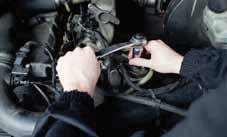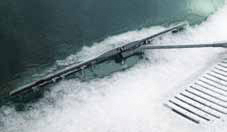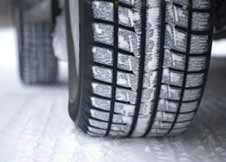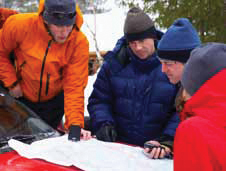CHECKLIST & TIPS FOR SAFE WINTER DRIVING


Get your car serviced now.
No one wants to break down in any season, but especially not in cold or snowy winter weather. Start the season off right by ensuring your vehicle is in optimal condition.
- Visit your mechanic for a tune-up and other routine maintenance.
- Have your entire vehicle checked thoroughly for any leaks, bad hoses, or other needed parts, repairs, and replacements.
Check your battery.
 |
When the temperature drops, so does battery power.
For gasoline powered engines also be aware that it takes more battery power to start your vehicle in cold weather than in warm. For electric vehicles the driving range is reduced. Find out if your battery is up to the challenges of winter by: |
- Having your mechanic check your battery for sufficient voltage;
- Having the charging system and belts inspected;
- If necessary, replacing the battery or making system repairs including simple things like tightening the battery cable connections; and
- Making sure, for electric vehicles with gasoline backup systems, to keep fresh gasoline in the vehicle to support the gasoline backup system.
Check your cooling system.
When coolant freezes it expands. This expansion can potentially damage your vehicle’s engine block beyond repair. Don’t let this happen to your vehicle this winter.
- Make sure you have enough coolant in your vehicle and that it’s designed to withstand the winter temperatures you might experience in your area.
- A 50/50 mix of coolant to water is sufficient for most regions of the country. See your vehicle owner’s manual for specific recommendations.
- Thoroughly check the cooling system for leaks or have your mechanic do it for you.
- If your system hasn’t been flushed (draining the system and replacing the coolant) for several years have it done now. Over time, the rust inhibitors in antifreeze break down and become ineffective. Coolant also needs to be refreshed periodically to remove dirt and rust particles that can clog the cooling system and cause it to fail.
Fill your windshield washer reservoir.
 |
- You can go through a lot of windshield wiper fluid fairly quickly in a single snow storm so be prepared for whatever Mother Nature might send your way.
- Completely fill your vehicle’s reservoir before the first snow hits.
|
- Use high-quality, “no-freeze” fluid.
- Buy extra to keep on hand in your vehicle.
Check your windshield wipers and defrosters.
Safe winter driving depends on achieving and maintaining the best visibility possible.
- Make sure your windshield wipers work and replace worn blades.
- If you live in an area that gets a lot of snow and ice, consider installing heavy duty winter wipers.
- Check to see that your window defrosters (front and rear) work properly.
Inspect your tires.
If you plan to use snow tires have them installed now before the snow storms hit. Check out www.safercar.gov for tire ratings before buying new ones. For existing tires check to ensure they are properly inflated as recommended by your vehicle manufacturer, the tread is sufficient with no uneven wear, and that the rubber is in good overall condition. Note that tire rubber starts to degrade after several years, and older tires need to be replaced even if they have not seen much wear.
Regardless of season, you should inspect your tires at least once a month and always before setting out on a long road trip. It only takes about five minutes. If you find yourself driving under less than optimal road conditions this winter you’ll be glad you took the time.
- Check tire pressure and make sure each tire is filled to the vehicle manufacturer’s suggested PSI (pounds per square inch) of air pressure which is listed in your owner’s manual and on a label inside the driver’s door. Tire pressure drops as the temperature drops. Properly inflated tires ensure optimum tire performance and optimum vehicle driving range.
 |
- Keep a tire pressure gauge in your vehicle at all times and check pressure when tires are “cold” — meaning they haven’t been driven on for at least three hours.
- Look closely at your tread and replace tires that have uneven wear or insufficient tread. Tread should be at least 1/16 of an inch or greater on all tires.
|
Know your car.
Every vehicle handles differently; this is particularly true when driving on wet, icy, or snowy roads. Take time now to learn how to best handle your vehicle under winter weather driving conditions.
- For electric vehicles, several things can be done to minimize the drain on the batteries. If the vehicle has a thermal heating pack for the batteries, make sure your vehicle is plugged in whenever it is not in use. If the vehicle has a pre-heat function to warm the car interior, set it to warm the passenger compartment before you unplug it in the morning.
- Practice cold weather driving when your area gets snow but not on a main road. Until you’ve sharpened your winter weather driving skills and know how your vehicle handles in snowy conditions it’s best to practice in an empty parking lot in full daylight.
- Drive slowly. It’s harder to control or stop your vehicle on a slick or snow covered surface. On the road, increase your following distance enough so that you’ll have plenty of time to stop for vehicles ahead of you.
- A word of caution about braking: Know what kind of brakes your vehicle has and how to use them properly. In general, if you have antilock brakes, apply firm, continuous pressure. If you don’t have antilock brakes, pump the brakes gently.
- If you find yourself in a skid, stay calm and ease your foot off the gas while carefully steering in the direction you want the front of your vehicle to go. Stay off the pedals (gas and brake) until you are able to maintain control of your vehicle. This procedure, known as “steering into the skid,” will bring the back end of your car in line with the front.
- When renting a car you should become familiar with the vehicle before driving it off the lot. For instance, you should know the location of the hazard lights in case of emergency. Take a minute to review the owner’s manual in the rental car so that you are prepped.
Plan your travel and route.
 |
Keep yourself and others safe by planning ahead before you venture out into bad weather.
- Check the weather, road conditions, and traffic; plan to leave early if necessary.
- Don’t rush! Allow plenty of time to get to your destination safely.
|
- Familiarize yourself with directions and maps before you go, and let others know your route and anticipated arrival time.
- Keep your gas tank close to full even with an electric vehicle. If you get stuck in a traffic jam or in snow, you might need more fuel to get home or keep warm. Note: To avoid carbon monoxide poisoning when stuck in snow be sure to keep your vehicle’s exhaust pipe clear of snow and ice. Run your vehicle only in the open with the windows partially down, and run it only long enough to keep warm.
- If road conditions are hazardous avoid driving if possible. Wait until road and weather conditions improve before venturing out in your vehicle.
Stock your vehicle.
Carry items in your vehicle to handle common winter driving tasks such as cleaning off your windshield as well as any
supplies you might need in an emergency. Keep the following on hand:
- Snow shovel, broom, and ice scraper;
- Abrasive material, such as sand or kitty litter, in case your vehicle gets stuck in the snow;
- Jumper cables, flashlight, and warning devices such as flares and markers;
- Blankets for protection from the cold;
- And a cell phone with charger, water, food, and any necessary medicine for longer trips or when driving in lightly populated areas.
Learn what to do in a winter emergency.
If you are stopped or stalled in wintry weather follow these safety rules:
- Stay with your car and don’t over exert yourself;
- Put bright markers on the antenna or windows and keep the interior dome light turned on;
- To avoid asphyxiation from carbon monoxide poisoning, don’t run your car for long periods of time with the windows up or in an enclosed space. If you must run your vehicle, clear the exhaust pipe of any snow and run it only
sporadically — just long enough to stay warm.
Protect yourself and your loved ones.
- Remember to always wear your seat belt. Ensure that everyone in your vehicle is buckled up as well.
- Do not text or engage in any other activities that may distract you while driving.
- While thick outerwear will keep your children warm they can also interfere with the proper harness fit of your child in their car seat. Place blankets around your child after the harness is snug and secure.
- Never leave your child unattended in or around your vehicle.






